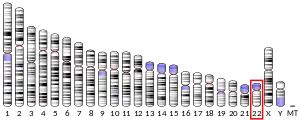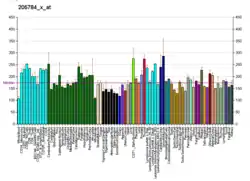| ARVCF | |||||||||||||||||||||||||||||||||||||||||||||||||||
|---|---|---|---|---|---|---|---|---|---|---|---|---|---|---|---|---|---|---|---|---|---|---|---|---|---|---|---|---|---|---|---|---|---|---|---|---|---|---|---|---|---|---|---|---|---|---|---|---|---|---|---|
| Identifiers | |||||||||||||||||||||||||||||||||||||||||||||||||||
| Aliases | ARVCF, armadillo repeat gene deleted in velocardiofacial syndrome, delta catenin family member, ARVCF delta catenin family member | ||||||||||||||||||||||||||||||||||||||||||||||||||
| External IDs | OMIM: 602269 MGI: 109620 HomoloGene: 31046 GeneCards: ARVCF | ||||||||||||||||||||||||||||||||||||||||||||||||||
| |||||||||||||||||||||||||||||||||||||||||||||||||||
| |||||||||||||||||||||||||||||||||||||||||||||||||||
| |||||||||||||||||||||||||||||||||||||||||||||||||||
| |||||||||||||||||||||||||||||||||||||||||||||||||||
| |||||||||||||||||||||||||||||||||||||||||||||||||||
| Wikidata | |||||||||||||||||||||||||||||||||||||||||||||||||||
| |||||||||||||||||||||||||||||||||||||||||||||||||||
Armadillo repeat protein deleted in velo-cardio-facial syndrome is a protein that in humans is encoded by the ARVCF gene.[5][6][7]
Function
Armadillo repeat gene deleted in Velo-Cardio-Facial syndrome (ARVCF) is a member of the catenin family which play an important role in the formation of adherens junction complexes, which are thought to facilitate communication between the inside and outside environments of a cell. ARVCF gene was isolated in the search for the genetic defect responsible for the autosomal dominant Velo-Cardio-Facial syndrome (VCFS) a relatively common human disorder with phenotypic features including cleft palate, conotruncal heart defects and facial dysmorphology. ARVCF gene encodes a protein containing two motifs, a coiled coil domain in the N-terminus and a 10 armadillo repeat sequence in the midregion. Since these sequences can facilitate protein-protein interactions ARVCF is thought to function in a protein complex. In addition, ARVCF contains a predicted nuclear-targeting sequence suggesting that it may have a function as a nuclear protein.[7]
Interactions
References
- 1 2 3 GRCh38: Ensembl release 89: ENSG00000099889 - Ensembl, May 2017
- 1 2 3 GRCm38: Ensembl release 89: ENSMUSG00000000325 - Ensembl, May 2017
- ↑ "Human PubMed Reference:". National Center for Biotechnology Information, U.S. National Library of Medicine.
- ↑ "Mouse PubMed Reference:". National Center for Biotechnology Information, U.S. National Library of Medicine.
- ↑ Sirotkin H, O'Donnell H, DasGupta R, Halford S, St Jore B, Puech A, Parimoo S, Morrow B, Skoultchi A, Weissman SM, Scambler P, Kucherlapati R (May 1997). "Identification of a new human catenin gene family member (ARVCF) from the region deleted in velo-cardio-facial syndrome". Genomics. 41 (1): 75–83. doi:10.1006/geno.1997.4627. PMID 9126485.
- ↑ Kausalya PJ, Phua DC, Hunziker W (November 2004). "Association of ARVCF with Zonula Occludens (ZO)-1 and ZO-2: Binding to PDZ-Domain Proteins and Cell-Cell Adhesion Regulate Plasma Membrane and Nuclear Localization of ARVCF". Mol Biol Cell. 15 (12): 5503–15. doi:10.1091/mbc.E04-04-0350. PMC 532029. PMID 15456900.
- 1 2 "Entrez Gene: ARVCF armadillo repeat gene deletes in velocardiofacial syndrome".
- ↑ Kaufmann U, Zuppinger C, Waibler Z, Rudiger M, Urbich C, Martin B, Jockusch BM, Eppenberger H, Starzinski-Powitz A (November 2000). "The armadillo repeat region targets ARVCF to cadherin-based cellular junctions". J. Cell Sci. 113 (22): 4121–35. doi:10.1242/jcs.113.22.4121. PMID 11058098.
External links
- Human ARVCF genome location and ARVCF gene details page in the UCSC Genome Browser.
Further reading
- Lindsay EA, Goldberg R, Jurecic V, Morrow B, Carlson C, Kucherlapati RS, Shprintzen RJ, Baldini A (1995). "Velo-cardio-facial syndrome: frequency and extent of 22q11 deletions". Am. J. Med. Genet. 57 (3): 514–22. doi:10.1002/ajmg.1320570339. PMID 7677167.
- Sirotkin H, Morrow B, Saint-Jore B, Puech A, Das Gupta R, Patanjali SR, Skoultchi A, Weissman SM, Kucherlapati R (1997). "Identification, characterization, and precise mapping of a human gene encoding a novel membrane-spanning protein from the 22q11 region deleted in velo-cardio-facial syndrome". Genomics. 42 (2): 245–51. doi:10.1006/geno.1997.4734. PMID 9192844.
- Bonné S, van Hengel J, van Roy F (1998). "Chromosomal mapping of human armadillo genes belonging to the p120(ctn)/plakophilin subfamily". Genomics. 51 (3): 452–4. doi:10.1006/geno.1998.5398. PMID 9721216.
- Mariner DJ, Wang J, Reynolds AB (2000). "ARVCF localizes to the nucleus and adherens junction and is mutually exclusive with p120(ctn) in E-cadherin complexes". J. Cell Sci. 113 (8): 1481–90. doi:10.1242/jcs.113.8.1481. PMID 10725230.
- Kaufmann U, Zuppinger C, Waibler Z, Rudiger M, Urbich C, Martin B, Jockusch BM, Eppenberger H, Starzinski-Powitz A (2001). "The armadillo repeat region targets ARVCF to cadherin-based cellular junctions". J. Cell Sci. 113 (22): 4121–35. doi:10.1242/jcs.113.22.4121. PMID 11058098.
- Laura RP, Witt AS, Held HA, Gerstner R, Deshayes K, Koehler MF, Kosik KS, Sidhu SS, Lasky LA (2002). "The Erbin PDZ domain binds with high affinity and specificity to the carboxyl termini of delta-catenin and ARVCF". J. Biol. Chem. 277 (15): 12906–14. doi:10.1074/jbc.M200818200. PMID 11821434.
- Sanders AR, Rusu I, Duan J, Vander Molen JE, Hou C, Schwab SG, Wildenauer DB, Martinez M, Gejman PV (2005). "Haplotypic association spanning the 22q11.21 genes COMT and ARVCF with schizophrenia". Mol. Psychiatry. 10 (4): 353–65. doi:10.1038/sj.mp.4001586. PMID 15340358.
- Ballif BA, Villén J, Beausoleil SA, Schwartz D, Gygi SP (2005). "Phosphoproteomic analysis of the developing mouse brain". Mol. Cell. Proteomics. 3 (11): 1093–101. doi:10.1074/mcp.M400085-MCP200. PMID 15345747.
- Ulfig N, Chan WY (2005). "Expression of ARVCF in the human ganglionic eminence during fetal development". Dev. Neurosci. 26 (1): 38–44. doi:10.1159/000080710. PMID 15509897. S2CID 34049725.
- Michaelovsky E, Frisch A, Leor S, Stein D, Danziger Y, Carel C, Fennig S, Mimouni M, Klauck SM, Benner A, Poustka A, Apter A, Weizman A (2006). "Haplotype analysis of the COMT-ARVCF gene region in Israeli anorexia nervosa family trios". Am. J. Med. Genet. B Neuropsychiatr. Genet. 139 (1): 45–50. doi:10.1002/ajmg.b.30230. PMID 16118784. S2CID 25227246.





